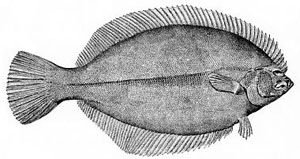Flounder facts for kids

Flounder are a type of flatfish. They are known for their unique flat bodies and how their eyes move as they grow! Flounder live on the bottom of the ocean, often in coastal areas like lagoons and estuaries. You can find them in the Atlantic Ocean and Pacific Ocean.
When a flounder is a baby, called a larva, it looks like a normal fish with one eye on each side of its head. But as it grows, one eye slowly moves across its head until both eyes are on the same side! This helps them see when they lie flat on the seafloor.
Contents
What Kinds of Flounder Are There?
There are many different kinds of flounder around the world. Scientists group them based on where they live and their features. Here are a few examples:
Flounder in the Western Atlantic Ocean
- Gulf Flounder (Paralichthys albigutta)
- Southern flounder (Paralichthys lethostigma)
- Summer flounder (also called fluke) (Paralichthys dentatus)
- Winter flounder (Pseudopleuronectes americanus)
Flounder in European Waters
- European flounder (Platichthys flesus)
Flounder in the Northwestern Pacific Ocean
- Olive flounder (Paralichthys olivaceus)
Where Do Flounder Live and What Do They Eat?
Flounder love to live in soft, muddy areas at the bottom of the sea. You can often find them near bridge supports, docks, and even coral reefs. They are masters of camouflage, meaning they can change their color to blend in perfectly with the sand or mud around them. This helps them hide from predators and sneak up on their food!
Believe it or not, flounder have been found in some of the deepest parts of the ocean! In 1960, two explorers, Jacques Piccard and Don Walsh, were surprised to see flounder about 30 centimeters (about 1 foot) long at the very bottom of the Mariana Trench. This is the deepest known ocean canyon, more than 10,900 meters (about 35,800 feet) deep!
Flounder are carnivores, which means they eat other animals. Their diet mainly includes small fish, crustaceans (like crabs and shrimp), and worms. Most flounder grow to be about 12.5 to 37.5 centimeters (5 to 15 inches) long. Some can even grow as large as 60 centimeters (about 2 feet)! Their body width is usually about half of their length.
Images for kids




